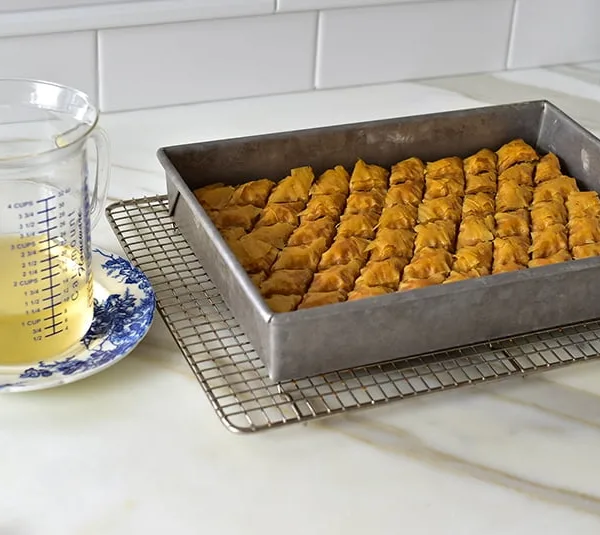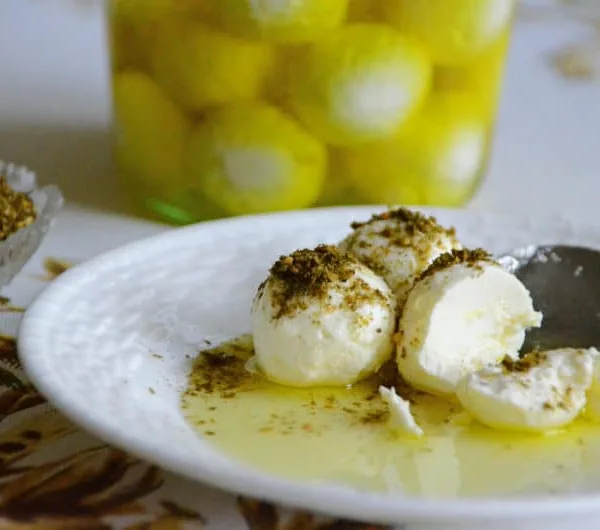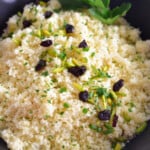This post may contain affiliate links. Please read our disclosure policy.
Learn how to cook couscous and all about this delicious pilaf. Couscous is simple to prepare, but knowing the types and how to cook and serve them makes couscous an easy addition to your repertoire.
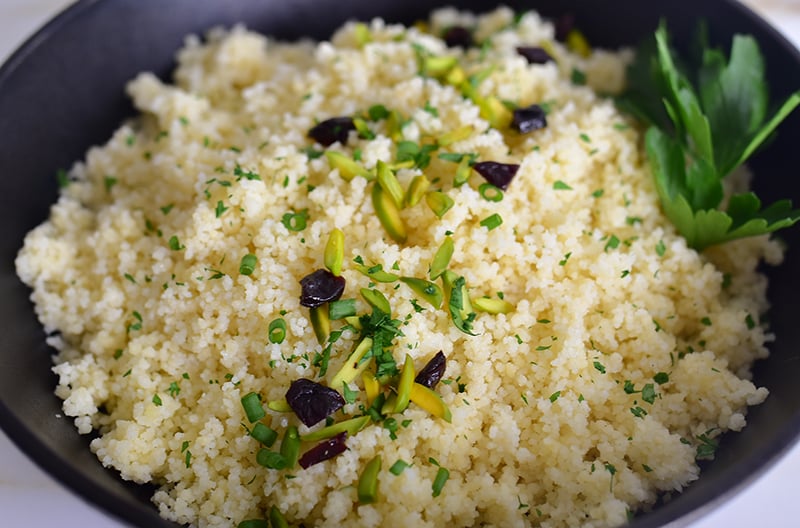
One of the most essential dishes of Middle Eastern and North African cuisine is couscous. This dish is often on restaurant menus as a side dish and it is easy to make at home, too. It’s both side dish and main dish, a neutral canvas for inclusion of other savory and sweet ingredients to give an otherwise bland pilaf great flavor and added nutrition.
There are several different types of couscous to choose from; all cook up very easily, similar to other small grains such as rice or small pastas. In Lebanese cuisine, couscous is maghrabia, which refers to both the pearl-style couscous and the comforting chicken and onion stew that is a Lebanese favorite.
Table of Contents
What Is Couscous?
Despite popular belief that couscous is a grain like rice or quinoa, it is actually a tiny pasta made from semolina flour. This may be surprising because its granules are such a small size, they very much resemble a grain, like fine bulgur wheat. But the resemblance stops there! The extra small, irregular pieces are a mixture of semolina flour and water, put through a mixing and drying process that creates the tiny spheres.
Couscous, being a pasta, is a starch, a carbohydrate. Rather bland on its own, it has the neutral taste of a comfort dish that can take on the flavor of whatever is added to it.
What is the origin?
It originates in Northwest Africa among Moroccans known at that time as Berbers. Morocco and Algeria claim the origin of couscous. It is “smida” in Morocco, which sounds similar to the Arabic “smeed” which refers to wheat semolina.
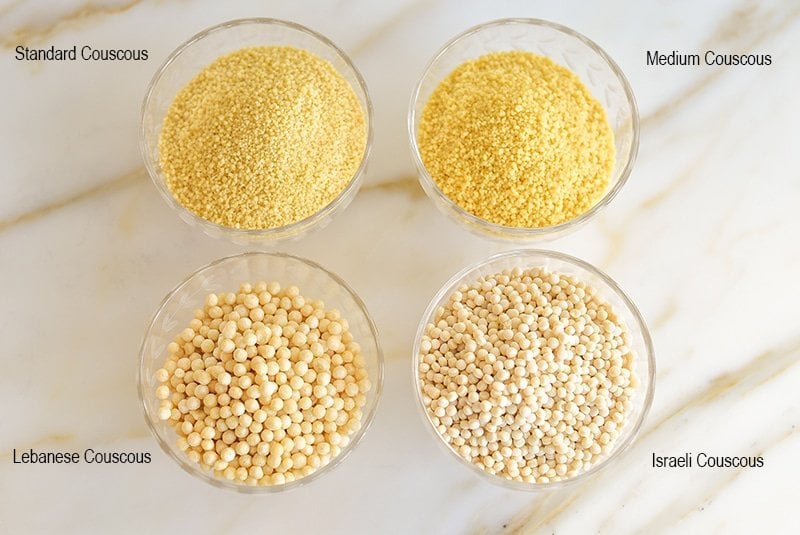
Types of couscous
Couscous is available in a variety of sizes. Different types vary in size from standard (the smallest size) to larger pearl couscous. The smallest of these is Moroccan, where it originated. Medium is less common a slightly larger granule than standard but still quite tiny (again, not unlike medium bulgur #2, in size and shape). Pearl is a slightly larger granule yet that resembles a small pearl. Isreali couscous is pearl. The largest pearl couscous is Lebanese, maghrabia.
What does it taste like?
Couscous is pasta . . . and it tastes much like pasta! It is a bland, gentle flavor on its own with a soft texture. Because the granules are so tiny, it is typically a pilaf-style dish, highly seasoned with spices and studded with other flavorful ingredients like herbs, nuts, and dried fruit. Couscous pairs well with saucy or juicy meats and vegetables because of its ability to soak up those flavors.
The standard or tiny-style has a more granular yet soft texture, while the larger pearl style is chewier, like the pasta that it is!
How to cook couscous
Cooking couscous is simple, the same way you cook rice, allowing the granules to absorb all of the liquid in the pot.
How to cook standard size
The recipe easily increases by cup measures to the amount you need. This is the most common couscous available in most markets.
1. Bring 1 cup of broth or water, with a dash of salt and teaspoon of olive oil or butter, to a boil.
2. Add 1 cup dry standard couscous. No rinsing is necessary before cooking.
3. Cover the pan and remove it from the heat (or turn off the heat) right away. It will absorb the liquid in the residual heat.
4. Let the pot rest for 7-10 minutes or until all of the liquid is absorbed. Fluff with a fork, the pilaf should be light without a gummy or gritty texture.
5. You are now ready for any flavorful additions such as fresh herbs, dried fruit, or other flavorings.
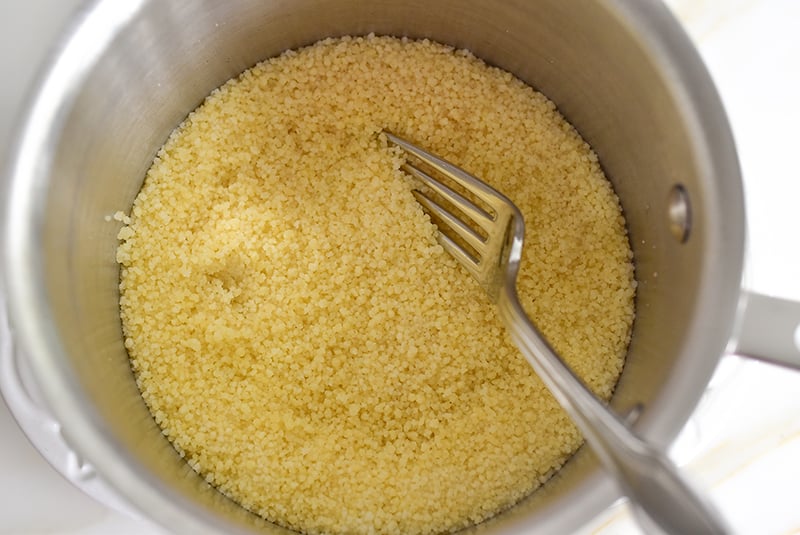
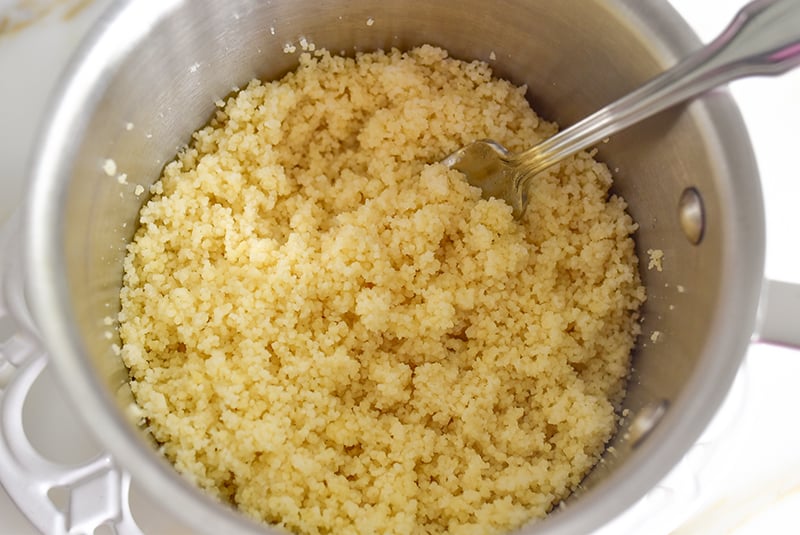
How to cook pearl size
The recipe easily increases by cup measures to the amount you need.
1. In a large sauce pan, add a teaspoon of kosher salt to 1 ½ cups water or broth. If using salted broth, the liquid does not necessarily need salt.
2. Bring the water to boil and add the pearl couscous. It does not need rinsing before cooking.
3. Cover the pot. Reduce the heat to low and continue to simmer until it is tender, about 15 minutes. Taste to see if it is soft and tender.
4. Stir and cool completely if using in a cold salad, or add flavorings now if serving as a warm dish.
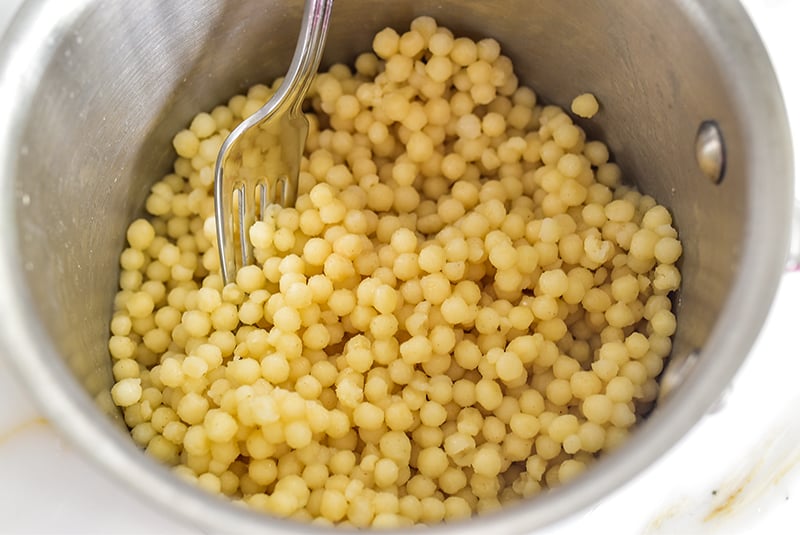
What can I add for flavor?
Couscous,with its neutral flavor, is like a blank canvas for deliciousness! Dress up it like this:
Use broth for the cooking liquid. Chicken broth, beef broth, or vegetable broth rather than water as the cooking liquid will add flavor to the couscous.
Toast the dry couscous granules or pearls before cooking for a nuttier flavor. In the same pot you’re going to cook the couscous in, first add a tablespoon of olive oil or butter to the pot over medium heat. Add the couscous, stirring constantly until golden brown. Proceed with adding boiling liquid to the pot and cook from there.
Add aromatics before cooking. Sauté onion and garlic in a tablespoon of olive oil or butter in the pan before proceeding with adding the couscous and boiling liquid to cook. Tuck in a bay leaf or bouquet garni (a bundle of thyme, parsley, and bay leaf).
Add fresh herbs and spices after cooking. Stir in a shower of chopped fresh herbs of any kind. Season with spices such as 7 Spice, dried mint, basil, dill, or coriander.
Add a pinch of lemon or lime zest and squeeze of lemon juice to brighten the flavors.
Nuts and dried fruit add texture and taste. Toasted pine nuts, slivered almonds, roasted pistachios or any of your favorite nuts add crunch and flavor. Try raisins, chopped dried apricots, and currants for chewy, sweet-tart dried fruits.
Make a pasta salad, adding your favorites as you would with any pasta salad: chopped onions, olives, cooked chickpeas or other legume, cucumber, carrots, salami. Dress with a vinaigrette or a creamy pasta salad dressing.
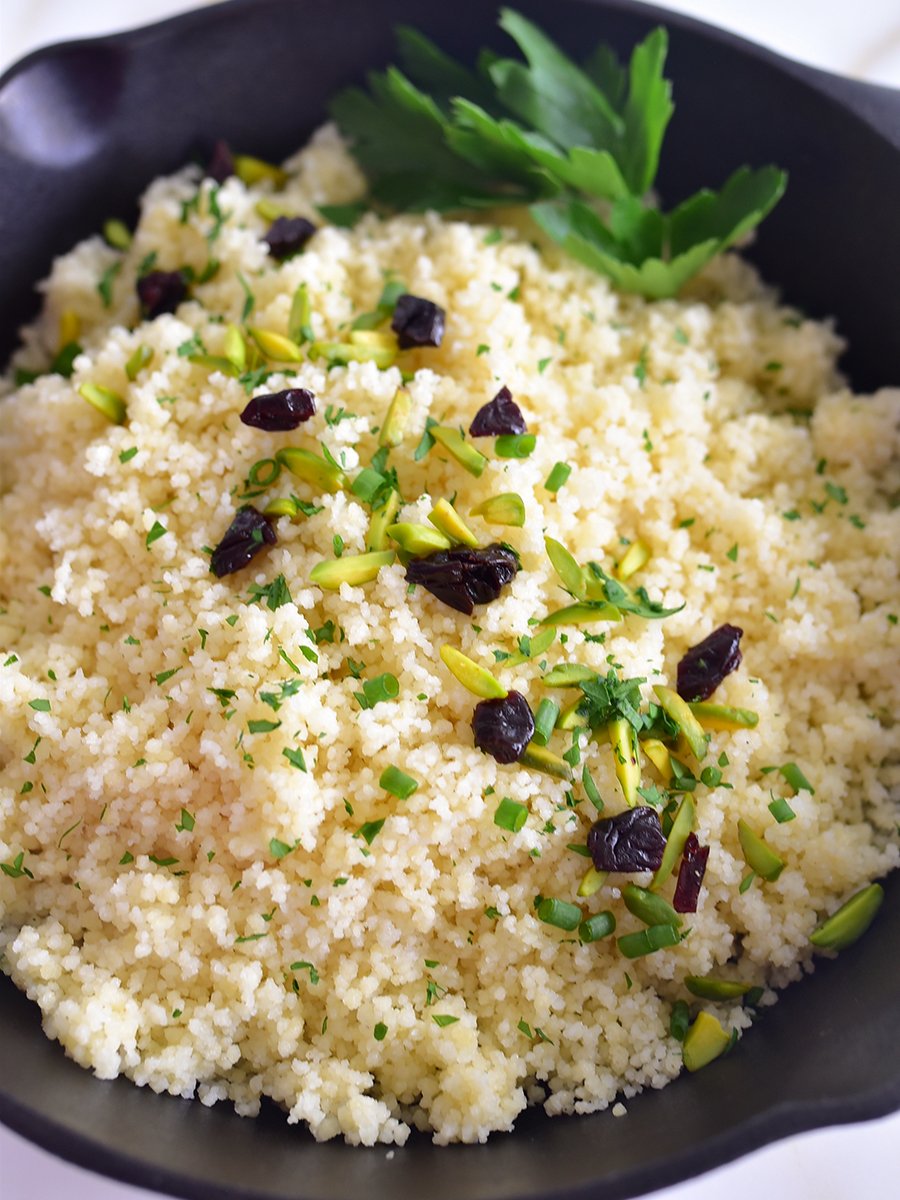
How to serve couscous
Serve as a warm side dish that compliments grilled or roasted meats or vegetables. Delicious with kebabs such as Lebanese Beef Kafta and Chicken Shawarma. Pearl couscous makes a great cold pasta salad like my Lebanese Couscous Salad. Serve about ⅓ cup per person. Couscous is a starch, so think of serving size as you would potatoes, rice, or other starch.
It also makes an excellent base for a bowl-style meal, layering meats, vegetables, beans, you name it!, for an easy and fun one-bowl meal. Set up a couscous bowl bar for a gathering.
Pearl couscous is a great choice for soups and stews (vegetable stew or meat stew). Among the world’s favorite couscous recipes, Lebanese Maghrabia is a chicken stew; the pearl or Lebanese couscous is an essential component.
What is Lebanese couscous?
This is the largest of all varieties, similar in both size and color to a chickpea. It has a nutty flavor, along with a chewier texture. Its heartier, dense nature makes it similar to very small pasta.
Lebanese moghrabieh is the largest of the varieties, with a pea-sized ball about 1/8 – 1/4-inch in size. Buy it dry, like pasta, or if you can find it, fresh.
What is Israeli couscous?
Israeli couscous, or pearl, is also a tiny hard ball that looks similar to the size of peppercorns in size and shape. This does not fluff when cooked, making it great for pilafs and also salads, similar to pasta salads.
Where to buy couscous
Find it at most any grocery store in the same section as the rice and pasta, or in the international section. Typically the standard size comes in a small box with other flavorings (follow package instructions to cook). The larger pearl styles can be more difficult to find. Look for them online (find Lebanese couscous in my shop!) and in specialty markets.
How to store it
Couscous of any size is a dry product that stores in the pantry the same as any pasta. Keep it in an airtight container in a dark, dry place and it will remain fresh for many months.
Store it (cooked) in an airtight container in the refrigerator for up to 5 days. Reheat with a splash of water in the microwave, or on the stovetop, until warm.
It also freezes well! Keep it plain for freezing; don’t include other ingredients such as meat or fresh herbs until serving. To freeze, transfer to a freezer bag or container, removing as much air as possible, for up to 4 months. To thaw, move the container to the refrigerator overnight or for a day.
Frequently Asked Questions
It is not gluten-free. Semolina, the primary ingredient in it, is a form of wheat, which contains gluten.
Couscous is a pasta!
Couscous is made from semolina flour and water.
Semolina is a type of wheat flour, which is coarsely ground durum wheat flour. Durum wheat is harder than common wheat.
All couscous is simply a form of pasta, made with semolina. Pearl couscous is made of semolina flour (from durham wheat).
The old world method requires a Moroccan pot called a couscoussier with three steamings. There are still some (but very few!) Lebanese in my family who make Lebanese couscous, maghrabia, by hand but this is labor intensive and, unfortunately, a dying art!
The only similarity between couscous and quinoa is the visual appearance of tiny granules that make up each. Quinoa is a natural grain (actually, a seed) that is remarkably high in protein, whereas couscous is a pasta that is made out of semolina flour. Quinoa is a gluten-free food while couscous contains gluten in the form of wheat. The flavor is different, though both are neutral flavors and a good base for other seasonings and ingredients.
Couscous can be higher in fiber and protein than plain white rice. Rice is a grain whereas couscous is a form of semolina pasta. Both are carbohydrates.
It is both delicious and nutritious, a healthy carbohydrate but still, a starch.
The word couscous originates in North Africa, meaning “well rolled” or “well formed.”
Lebanese call it maghrabia/maghribiyya. Palestinians call it matfūl or matfoul, which is another name for the pearl size that is between Israeli and Lebanese, referring also to the dishes made with the it.
Any variety makes a delicious base for salads and pilafs. Think of pasta salad and use that as a guide: vegetables, herbs, feta cheese, spices, legumes such as chickpeas or lentils. Add chicken or salmon for added protein, flavor, and variety. Also think of rice pilaf as a guide for ideas, adding onion, garlic, sautéed vegetables, nuts, you name it.

How to Cook Couscous
Ingredients
- 1 cup standard couscous or pearl couscous
- 1 teaspoon kosher salt
- 1 teaspoon extra virgin olive oil
- Water or broth, quantity depending on couscous size
Instructions
For standard couscous:
- In a small saucepan, bring 1 cup of liquid to a boil with the salt and olive oil.
- Add the couscous, cover, and remove the pot from the heat. Allow the pot to rest for about 7 minutes, or until all of the liquid is absorbed.
- Fluff the couscous with a fork. Add flavorings, if using, and serve.
For pearl couscous:
- In a small saucepan, bring 1 1/2 cups of liquid to a boil with the salt and olive oil.
- Add the pearl couscous, cover, and reduce the heat to low. Cook for about 15 minutes, or until all of the liquid is absorbed and the couscous is tender.
- Proceed with making a couscous salad, adding to a stew, or serving with seasonings added.
Notes
Nutrition information is automatically calculated, so should only be used as an approximation.


